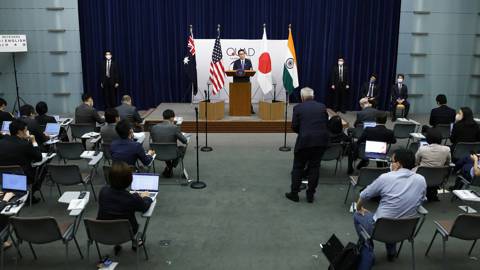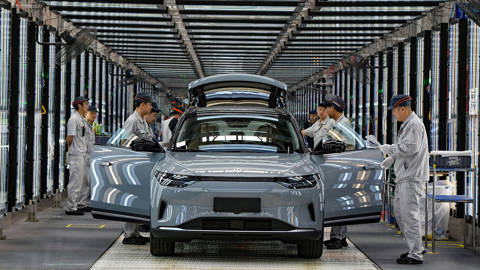Relations between China and Latin America are paradoxical. While bilateral trade has increased and diplomatic relations have strengthened in the past few years, a lack of knowledge persists between the two regions, and in some cases tensions are growing.
Relations between China and Latin America and the Caribbean are paradoxical. While bilateral trade has increased and diplomatic relations have strengthened in the past few years, a lack of knowledge persists between the two regions, and in some cases tensions are growing. Hardly any major projects between China and Latin America have been initiated by the private, public, or academic sectors, and bilateral institutions do not yet reflect the weight of economic dynamics.
There are two aspects to this paradox. First, many Chinese enterprises – particularly in basic-goods sectors such as soy, meat, iron, steel, copper, and oil – have initiated activities in Latin America, either through direct investment or by buying products and/or businesses. To a lesser degree, Latin American enterprises – such as Gruma, Modelo, Embraer, Marco Polo, and Embraco – have successfully introduced themselves in China.
Even so, Latin America remains a secondary economic and commercial partner for China. In 2006, Latin America and the Caribbean accounted for 3.7% of China’s exports and 4.3% of its imports. But bilateral trade has been growing at impressive rates, with Chinese exports and imports up by 24.8% and 23.9%, respectively, from 1995 to 2006.
Indeed, for practically all of Latin America’s countries, China is one of the ten main trade partners – and already in second place in several – with rates of growth well above total trade. Even in the Caribbean and Central American countries – several of which do not have diplomatic relations with China – commerce has been prolific.
Second, China’s large-scale penetration of the United States and European Union markets has, in many cases, displaced Asian and Latin American competitors. In the case of the US, for example, Latin America’s share of total imports, at roughly 17%, has not grown since 2000. In fact, major producers like Argentina, Brazil, and Mexico have seen their participation in US imports decrease, whereas China’s increased to 16% 2006, from 3% in 1990.
China represents a strong ideological challenge for the region, particularly for the status quo of economic policy promoted by the majority of multilateral institutions since the 1980’s. China would seem to fit the profile of “the worst student who got the best job,” with its GDP per capita growing – under “ideologically erroneous” conditions – 17.3 times faster than in Latin America from 1980 to 2005.
Contrary to most of Latin America, China’s public sector is omnipresent, exercised through direct ownership or control of incentives in the private sectors. Nor has it liberalized labor and product markets, and it maintains strict control over the exchange rate and capital account. Likewise, it develops five-year plans –and in many cases, such as in science and technology, plans that exceed 15 years.
Even so, with its cheaper labor force and faster technological growth, China has attained higher export competitiveness than Latin America, several of which it has displaced in key sectors, such as thread and dry goods manufacturing, electronics, and furniture, since 2000. Whereas China exports manufactured products with an increasing level of technological inputs, Latin America continues to export basic goods with a minimum of added value.
China represents a massive challenge even for countries, such as Brazil, that have achieved a significant trade surplus up to now. So dividing Latin American countries into “winners” and “losers” makes no sense. Aside from importing basic goods, China exports manufactured goods throughout the region. According to the Brazil-China Business Council, Brazil will have its first trade deficit with China in 2007, despite growth exports of minerals and agricultural products. Central America and Mexico have been running bilateral deficits for years, with Mexico’s import/export ratio in 2006 at 16:1.
Latin American countries would thus benefit from an open, non-ideological, and critical analysis of development experiences in the past few decades. They also need an effective rapprochement – going beyond diplomacy – that implies greater investment in bilateral institutions. Otherwise, relations between China and Latin America will be far from harmonious, even as their significance continues to grow.









Relations between China and Latin America and the Caribbean are paradoxical. While bilateral trade has increased and diplomatic relations have strengthened in the past few years, a lack of knowledge persists between the two regions, and in some cases tensions are growing. Hardly any major projects between China and Latin America have been initiated by the private, public, or academic sectors, and bilateral institutions do not yet reflect the weight of economic dynamics.
There are two aspects to this paradox. First, many Chinese enterprises – particularly in basic-goods sectors such as soy, meat, iron, steel, copper, and oil – have initiated activities in Latin America, either through direct investment or by buying products and/or businesses. To a lesser degree, Latin American enterprises – such as Gruma, Modelo, Embraer, Marco Polo, and Embraco – have successfully introduced themselves in China.
Even so, Latin America remains a secondary economic and commercial partner for China. In 2006, Latin America and the Caribbean accounted for 3.7% of China’s exports and 4.3% of its imports. But bilateral trade has been growing at impressive rates, with Chinese exports and imports up by 24.8% and 23.9%, respectively, from 1995 to 2006.
Indeed, for practically all of Latin America’s countries, China is one of the ten main trade partners – and already in second place in several – with rates of growth well above total trade. Even in the Caribbean and Central American countries – several of which do not have diplomatic relations with China – commerce has been prolific.
Second, China’s large-scale penetration of the United States and European Union markets has, in many cases, displaced Asian and Latin American competitors. In the case of the US, for example, Latin America’s share of total imports, at roughly 17%, has not grown since 2000. In fact, major producers like Argentina, Brazil, and Mexico have seen their participation in US imports decrease, whereas China’s increased to 16% 2006, from 3% in 1990.
China represents a strong ideological challenge for the region, particularly for the status quo of economic policy promoted by the majority of multilateral institutions since the 1980’s. China would seem to fit the profile of “the worst student who got the best job,” with its GDP per capita growing – under “ideologically erroneous” conditions – 17.3 times faster than in Latin America from 1980 to 2005.
SPRING SALE: Save 40% on all new Digital or Digital Plus subscriptions
Subscribe now to gain greater access to Project Syndicate – including every commentary and our entire On Point suite of subscriber-exclusive content – starting at just $49.99.
Subscribe Now
Contrary to most of Latin America, China’s public sector is omnipresent, exercised through direct ownership or control of incentives in the private sectors. Nor has it liberalized labor and product markets, and it maintains strict control over the exchange rate and capital account. Likewise, it develops five-year plans –and in many cases, such as in science and technology, plans that exceed 15 years.
Even so, with its cheaper labor force and faster technological growth, China has attained higher export competitiveness than Latin America, several of which it has displaced in key sectors, such as thread and dry goods manufacturing, electronics, and furniture, since 2000. Whereas China exports manufactured products with an increasing level of technological inputs, Latin America continues to export basic goods with a minimum of added value.
China represents a massive challenge even for countries, such as Brazil, that have achieved a significant trade surplus up to now. So dividing Latin American countries into “winners” and “losers” makes no sense. Aside from importing basic goods, China exports manufactured goods throughout the region. According to the Brazil-China Business Council, Brazil will have its first trade deficit with China in 2007, despite growth exports of minerals and agricultural products. Central America and Mexico have been running bilateral deficits for years, with Mexico’s import/export ratio in 2006 at 16:1.
Latin American countries would thus benefit from an open, non-ideological, and critical analysis of development experiences in the past few decades. They also need an effective rapprochement – going beyond diplomacy – that implies greater investment in bilateral institutions. Otherwise, relations between China and Latin America will be far from harmonious, even as their significance continues to grow.